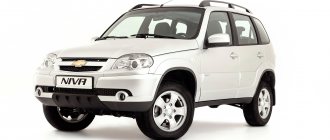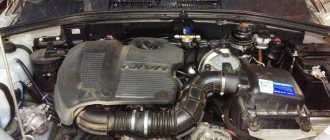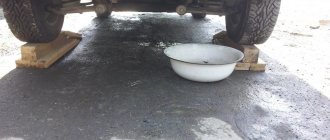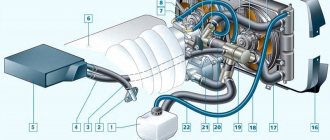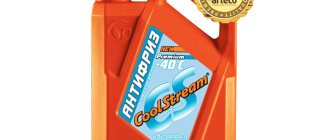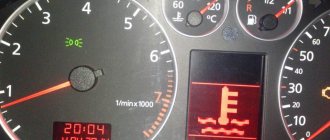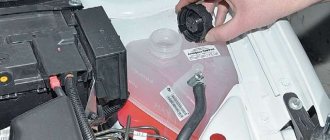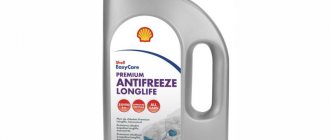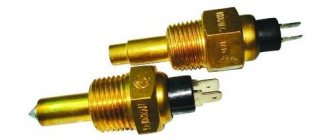Replacement instructions
The procedure for replacing the coolant is not complicated, so even a novice car enthusiast can perform it.
How much to pour?
Antifreeze in a car, according to the manufacturer’s recommendations, should be changed after 40 thousand kilometers or after two years of operation. In this case, it is necessary to constantly monitor the condition of the coolant and check its level. If it has darkened or become cinnamon in color, then it needs to be changed. If the level is below the required level, add water or antifreeze. Replacement may be required if the coolant poured into the car does not meet the density.
The required volume of liquid to be filled is 10 liters. It is advisable to fill with coolant specified in the owner's manual.
Coolant
What will you need?
To carry out the replacement, you will need an inspection hole, a lift or an overpass. The machine must be installed horizontally and secured so that it cannot roll during work. The front of the machine should be installed higher than the rear. The procedure is carried out only on a cold engine. To carry it out you need to prepare the following tools and materials:
- spanner set to “10”;
- pliers;
- screwdriver;
- funnel;
- container for draining waste liquid;
- new antifreeze;
- clean rag.
A watering can can be made from a plastic bottle by cutting it in half. A canister or plastic water bottle is suitable as a container.
Stages
Having installed the car on the inspection hole, they begin to replace the coolant.
- First, open and secure the hood.
- The next step is to unscrew the cap on the expansion tank. It is advisable to perform the procedure on a cold machine.
Expansion tank Niva Chevrolet
If this is not possible, then the coolant temperature should be no higher than 90 degrees. To avoid getting burned by steam or hot liquid, place a rag on the engine and around the neck of the expansion tank. The lid should be unscrewed carefully. First you need to unscrew it a little so that hot air comes out and release the tank from pressure, and then unscrew it completely. - Now unscrew the plug on the drain hole and drain all the liquid. When the used antifreeze has drained, screw the plug back into place.
- To prevent the formation of air plugs in the cooling system, you need to disconnect the hose from the throttle body fitting. To do this, use a screwdriver or pliers to loosen the fastening on the clamp and move it back. Then disconnect the hose from the throttle assembly fitting.
- Before adding coolant, it should be prepared. There are ready-to-use liquids, mainly antifreeze. There are antifreezes that require dilution with distilled water; usually the proportion is 50/50, unless otherwise indicated in the instructions.
- Next, you can proceed to filling the cooling system.
Coolant is poured into the expansion tank. As soon as it begins to flow out of the throttle body nozzle, put the hose on the nozzle and tighten the hose clamp. Next, continue to fill the antifreeze solution to the maximum mark in the expansion tank.
- When pouring antifreeze solution, tighten the radiator hoses to prevent air pockets from forming.
- After the cooling system is filled, tighten the cap on the expansion tank.
- Next, you need to start the engine and wait for the electric fan to turn on. If this does not happen, you need to check what kind of air is coming from the heater. If it is warm, then the fan is faulty, if it is cold, the reason is the presence of air pockets formed in the system. To get rid of them, you need to open the cap on the radiator, start the engine, and after 5 minutes of operation, turn off the engine. Now close the radiator cap.
Removing the radiator cap - When the second cooling circle opens, the coolant level will drop significantly.
- You must wait until the engine cools down. Next, check the fluid level again. On a cold engine it should be between maximum and minimum, on a hot engine it should be at maximum. If necessary, add to the required volume.
The number of these elements in each vehicle may vary. In addition, it is important to have a clear understanding of the location, types, engine and transmission oil used, types of lubricants and fluids.
After all, they must be filled out taking into account the plant’s recommendations so that all systems can fully operate.
This is interesting: How to properly change the oil in a variator
How to change the oil in the transfer case
For a Chevrolet Niva, the oil change in the transfer case is performed after 50-80 thousand km or more often
(in difficult road conditions). After exceeding the total mileage of 120 thousand kilometers, it is recommended to reduce the frequency of oil changes to 45 thousand km.
Did you know?
Not all car instructions can be trusted.
Experienced drivers recommend updating the oil somewhat more often than indicated in the owner's manual. Country roads lead to the accumulation of dust and dirt in the car's oil, thereby polluting the driving mechanisms. In addition, moisture from the environment gets into the oil. Lubricants play a critical role in eliminating contaminants and other foreign substances. It is better to carry out work after trips (at least 5 km) in order to heat the oil in the car’s mechanisms, in this case in the transfer case. This is how liquids acquire excellent fluidity.
Changing the oil in the transfer case is not a difficult task, but it requires a painstaking approach. You will need an inspection hole, or you can use a lift. First, prepare an empty container for liquid technical waste and rags to remove spills. You also need a size 12 hex wrench and a refill syringe.
So, how to pour oil into the Niva box? The work is performed in the following order:
Important!
In order not to miss the next transmission oil change, do not forget to record the mileage at which the oil change was performed.
Niva Chevrolet: cooling system
Engine operation at normal temperature conditions is ensured by the functioning of the components included in its composition . This is a closed-type pipeline with forced ventilation.
List of elements providing heat exchange:
- Pump for pumping water.
- Thermostat.
- Fans.
- Radiator.
- Expansion tank.
The pump operates under the influence of centrifugal force . As the blades rotate, coolant is pumped, creating a pressure difference, so the antifreeze moves along the line.
For the efficient functioning of the heat exchanger, which includes a radiator, a thermostat is provided to open and close the movement of coolant in a circle. The latter is necessary to maintain balance in the system and has factory settings - it opens at a temperature range from 75 to 80°C.
The radiator contains two tanks connected horizontally by aluminum channels:
- one receives coolant;
- from the other - coolant comes out.
Heat exchange is provided over the radiator area.
When heated, a liquid tends to expand. To avoid the creation of excess pressure, an expansion tank is designed to receive it . The latter is equipped with a cover with a bypass valve to increase the pressure in the system. By switching to a closed type, it was possible to increase the boiling point and eliminate losses due to leakage from the tank.
Airflow of the heat exchanger is provided by fans operating in two modes:
- at 90°C;
- at 102°C.
Problem
Every second letter contains a question and a request: explain why I do not recommend a domestic product. After all, unlike oils, Niva antifreeze is a fairly simple thing. There are two reasons.
- At one time it was customary to criticize GOST standards. Now we will break everything, there will be competition and it will be good. It turned out to be bad)) The only regulatory act that exists today is GOST 28084–89, which was adopted during the Soviet era. And even today it is quite outdated, even for the domestic automobile industry. But in our country we have such magical standards, which are called TU (technical conditions). And for each area they are different. That is, the military has its own specifications for tank coolant. And the Ministry of Agriculture has its own specifications - for the ZIL-130 car. Can you imagine what a riot this is for imagination?? And most importantly, the manufacturer does not deceive you)))
- I am a bad chemist, to be more honest - very bad, and to be completely honest - then none at all)) Therefore, this paragraph was written under the dictation of a professor at the St. Petersburg Institute of Technology)) Ethylene glycol is a fairly expensive product, so our Papuans replace it with cheap bodyagi, consisting of glycerol and methanol. And if the first component is very harmful to the cooling system, then the second is simply incompatible with human health. And the methyl compound with water at temperatures above 50-60 degrees begins to “gnaw” aluminum. In chemistry, this term is called “etching.” And one more funny moment. Methanol evaporates when heated, the client adds water. So the process is repeated several times. As a result, the system simply produces colored water, which will freeze at the first frost.
Replacing Chevrolet Niva coolant
Tools:
- Ratchet wrench
- Extension
- 8 mm head
- 10 mm head
- 13 mm head
- Narrow nose pliers
- Torque wrench
- Knife
- Funnel
Parts and consumables:
- Coolant 8 l (10 l with reserve)
- Technical capacity
- Radiator Cap O-ring (if required)
- Plastic bottle
- Rags
Notes:
According to the Chevrolet Niva maintenance regulations, the coolant should be replaced after two years of operation or after 60 thousand kilometers, whichever comes first. In addition, if the coolant changes color to a reddish color, replace it immediately, as such a change indicates that inhibitory additives have developed and the liquid has become aggressive towards the parts of the cooling system.
Replace coolant only when the engine is cold.
1. Place the car on a ditch and open the hood.
2. Remove the oil pan guard and engine splash guard as described here.
Note:
The crankcase protection and mudguard may not be removed, but in this case you will have to use some kind of device to collect the drained liquid, otherwise it will inevitably spill across the area under the car.
3. Relieve excess pressure in the cooling system by unscrewing the expansion tank cap.
4. Place a wide container with a volume of at least 8.5 liters under the drain hole located at the bottom of the left radiator tank. To reduce the intensity of liquid drainage at the initial moment, the cap of the expansion tank should be tightly screwed on.
5. Unscrew the radiator drain plug by hand and drain the coolant from the radiator into a nearby container.
Notes:
Coolant is toxic and lethal to all living things, so be careful when working with it. To avoid polluting the environment, drain the radiator through a funnel (such as one made from a plastic soda bottle).
The drain plug is sealed with a rubber ring. Replace a ring that is torn, cracked or has lost elasticity.
6. Unscrew the cap of the expansion tank.
7. To drain the coolant from the engine cooling jacket, place a container under the drain hole located on the left side of the cylinder block next to the ignition module, and unscrew the drain plug with a 13 mm socket and extension.
8. The connection between the plug and the cylinder block uses a conical thread that does not require additional sealing. Close the radiator and cylinder block drain plugs. Tighten the drain plug of the cylinder block to a torque of 25-30 N∙m.
9. Before filling the cooling system with liquid, remove the engine screen (if any), use narrow-nose pliers to loosen the clamp securing the coolant supply hose to the throttle body and remove the hose from the pipe.
10. Pour coolant into the engine cooling system through the expansion tank until coolant flows out of the coolant supply hose to the throttle body. After this, install the hose in place and secure it with a clamp.
Note:
Use coolants recommended by the manufacturer.
11. Close the cap of the expansion tank.
Note:
Screw the expansion tank cap tightly. The expansion tank is under pressure when the engine is running, and therefore, if the plug is loosely tightened, coolant may leak from under it.
12. Start the engine. When the engine warms up, the outlet (lower) radiator hose should be cold for some time, and then quickly heat up, which will indicate the beginning of fluid circulation in a large circle. After waiting for the cooling fan to turn on, stop the engine.
Note:
When starting the engine, the expansion tank cap must be closed.
With the engine running, monitor the coolant temperature according to the gauge. If the arrow reaches the red zone and the fan does not turn on, turn on the heater and check what kind of air flows through it. If the heater supplies heated air, it means that the fan is most likely faulty, and if it is cold, it means that an air lock has formed in the engine cooling system. But there shouldn’t be a plug, since the cooling system was depressurized before adding liquid (see point 9).
13. After the engine has cooled, check the coolant level in the tank and bring it to normal (it should be between the MIN and MAX marks).
14. After a few days of using the car after replacing the coolant, check its level. If necessary, add coolant.
Note:
If, after a very short time, fresh antifreeze changes color from blue to brown, it means that you filled it with a fake, to which the manufacturers “forgot” to add corrosion inhibitors. In addition, one of the signs of a fake is the sudden complete discoloration of antifreeze. The dye of high-quality antifreeze is very stable and only darkens over time. Antifreeze tinted with linen blue becomes discolored. This “antifreeze” needs to be replaced quickly.
The article is missing:
- Photo of the instrument
- Photos of parts and consumables
Reservoir for windshield and brake fluid.
Another filling capacity of the Chevrolet Niva is two glass washer reservoirs, the capacity of which is five and two liters.
This model has two independent braking systems. The working one has a hydraulic drive, the parking one has a mechanical drive. The contours are separated from each other.
The hydraulic drive includes a special tank made for brake fluid.
- DOT-4 brake fluid is suitable for half-liter hydraulic brakes. The product has improved characteristics and has a boiling point of over 235 degrees. Well suited for regions with low ambient temperatures.
- SAEJ1703, FMSS116 are used for the entire hydraulic system and clutch release (0.15 l). The synthetic product provides good lubrication and reduces oxidation at high temperatures.
- The tank lid hatch hinges, door and hood locks require VTV-1 and FIOL-1 greases. Hinges of steering rods and cardan shafts - ShRB-4, Litin 2, Esma.
- The air conditioner also has two tanks. One of them is for oil (0.22 l), the other is for refrigerant (0.650 kg).
Chevrolet Niva reservoirs for refilling liquids and lubricants are quite reliable and convenient when you need to make a replacement.
Various tags and sensors make it possible to carry out control almost immediately, which allows you to avoid an emergency situation.
Main elements of the system
The largest and most basic element is the fuel tank, but the total number reaches sixteen. Their volumes vary greatly. Features of containers for refilling liquids in the Chevrolet Niva:
- they are necessarily included in the engine cooling and lubrication systems;
- Axle housings and gearboxes are also extremely important for safety during travel;
- Niva Chevrolet filling tanks include power steering systems and hydraulic brake lines, front and rear shock absorbers;
- An integral part are reservoirs for windshield washer and air conditioning.
Almost all tanks are made of plastic and stainless steel, capable of withstanding an aggressive hydrocarbon environment for a long time.
Removing the smell of antifreeze from the interior
The presence of antifreeze under the driver's mat is considered one of the common causes of the “odor.” Liquid leaks from cracks in pipes are subject to evaporation, causing a specific “aroma”. These mechanical problems can be eliminated by replacing all inlet and outlet pipes.
The smell is eliminated by dry cleaning, ozonation, deodorization and long-term ventilation of the interior.
Replacing the cooling radiator
The smell is caused by an old, faulty (not removed) heater radiator, where some antifreeze remains. As the liquid evaporates, it inevitably becomes a scourge of the cabin air. Eliminating this begins with disassembling the unit and eliminating defects.
The reason for replacing the heater radiator is the presence of cracks, breakages of the side tanks, tubes, often aluminum.
The leakage of odor from the engine section, caused by leaking pipes when the engine is warm, allows antifreeze vapors to enter the passenger compartment. It can be eliminated by inspecting the cooling system and eliminating defects.
Fuel tank characteristics
The fuel tank of this model has almost sixty liters, or more precisely 58. On average, per hundred kilometers you have to spend 8-9 liters of AI-95, Premium-95 or AI-92 gasoline. Features of the fuel container:
- the tank is located directly under the rear seat;
- in the upper part there is a small hatch under which the fuel pump is installed;
- The sensor will help determine the level of fuel fluid and the amount of gasoline.
There are other Chevrolet Niva filling tanks , many of which are included in various systems.
This is interesting: What is the volume of oil in a T 40 engine
Checking the volume and condition of the oil
The level of remaining oil in the transmission is checked with a special dipstick, which shows two dimensional marks - Max and Min. Using them you can determine whether there is enough oil in the box. If the fluid is below the minimum standard (Min), then you will still have to add a little oil. At the same time, it is important to prevent overflow, otherwise another problem will arise - you will have to crawl under the hood and drain the excess oil. The oil is brought to the optimal level - between the Max and Min marks. This procedure can be completed in a few minutes, but unfortunately, it is only relevant for short runs.
Replacement frequency - what antifreeze to fill
Coolant gradually loses its properties as it constantly circulates inside the car system. Thermal conductivity is lost, the level of inhibitors decreases and foaming begins.
If the antifreeze is not replaced in a timely manner, this may cause metal corrosion and engine overheating.
Replacement times depend on:
- Product quality.
- Vehicle operating conditions.
The procedure is carried out on average once every 2-3 years . According to the established regulations, antifreeze is replaced every five years or after a mileage of 250,000 km per year.
But in some cases this period is reduced for the following reasons :
- Presence of sediment or cloudiness in the expansion tank.
- A deposit of a jelly-like mass has formed on the inside of the tank, near the neck. Even if this is noticeable at subzero temperatures, there is a need for replacement.
Attention! If the antifreeze has turned brown or rusty in color, then it must be replaced urgently, as the metal has begun to actively rust.
The volume of coolant poured depends on the engine volume and is 6.3-10 liters.
Regulations
In the case of the Chevrolet Niva, the plant recommends replacing the transmission substance every 45 thousand kilometers. It is noteworthy that in this case the manufacturer took into account difficult operating conditions. However, this car is precisely intended for heavy road testing. The SUV tolerates overloads well, and the powerful and durable suspension provides excellent ride comfort and outstanding cross-country ability. We are talking about something else - the service life of the oil, which in such operating conditions will have to be changed much more often than required according to the regulations. Therefore, the 45 thousand kilometers limit can be called conditional. In addition, the endurance of the oil is also negatively affected by the human factor, namely the driver’s mistakes, which he makes in harsh conditions - for example, he incorrectly shifts from one gear to another (or does not operate the clutch correctly), constantly exceeds the speed, makes sudden maneuvers, etc. etc. At the same time, you can add here dirt and slush on the roads, high humidity, and various precipitation (for example, rain with snow and hail). Based on this, we can conclude: even if the car is adapted to heavy loads, this does not mean that the oil in such conditions is also designed for a long service life. Over time, it will lose its properties, but in this situation it will happen much earlier. Therefore, more frequent oil changes cannot be avoided. For example, experienced Niva owners prefer to reduce the regulations to 30 or 25 thousand. In addition, they check the oil volume in advance and constantly monitor its condition.
Video
The Chevrolet Niva has been produced since 2002, and in 2009 the model was restyled, the front and slightly rear lights changed. The car has not changed technically for 14 years.
The Chevrolet Niva is a full-fledged all-wheel drive SUV with locks, with a starting price from 519 thousand in the minimum wage and up to 619 thousand rubles, which is very good, since there are no competitors in the price range, none at all, the same Duster, although all-wheel drive, is not as good as the Niva’s cross-country ability in general doesn't pull. Even the same Patriot costs 150 thousand more.
The Niva has only one engine, 1.7 liters and a power of a crazy 80 horses))). There is no choice of power units, none at all. The engine cannot be called problematic, with timely maintenance, more than 300 thousand km go without major repairs, but minor problems will appear, such as a stuck throttle at 20 thousand km, which manifests itself in jumping and not falling revolutions. If the Niva starts to jerk and stall, it’s time to clean and possibly change the fuel pump. According to that, every 60 thousand, replace the coolant. It is better to immediately replace the spark plugs with denso W20EPRU. By the way, the engine is a chain engine, so the chain is replaced once every 150 thousand, or when it stretches and starts to rattle around the body. This engine is voracious in the city - about 14-17 liters, on the highway - about 8 liters. Don’t expect any special agility from the engine, it runs fine)))
